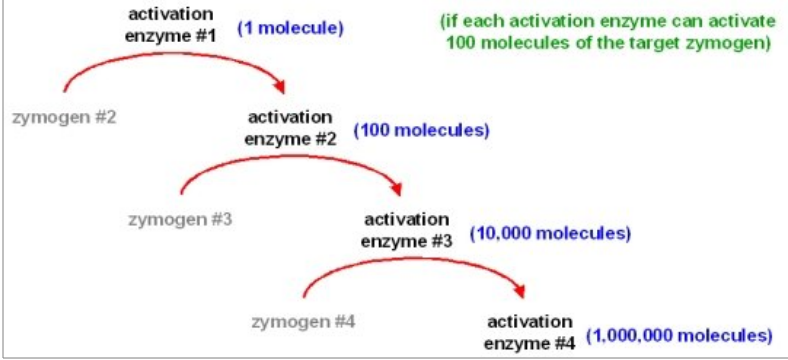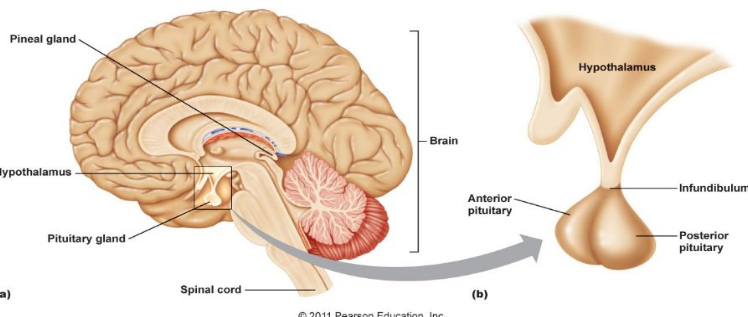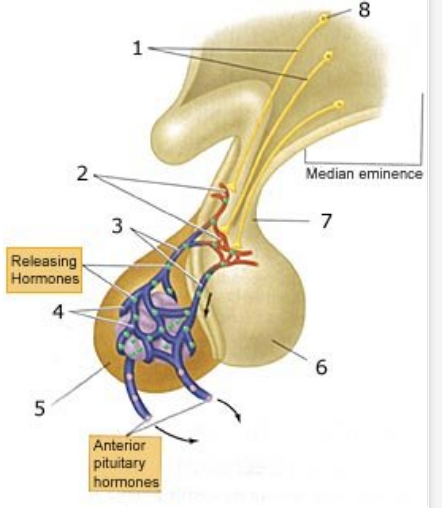semester 1 exam human bio
1/527
There's no tags or description
Looks like no tags are added yet.
Name | Mastery | Learn | Test | Matching | Spaced |
|---|
No study sessions yet.
528 Terms
What are the types of Glands?
Exocrine / Endocrine
What are exocrine glands?
Glands that secrete into a duct, carries secretion to body surface/ cavities (sweat, mucous)
what are endocrine glands?
glands that secrete hormones into extracellular fluid
which surrounds the cells making up the gland
- uses blood of transport
(eg, pituitary gland, thyroid, pancreas, gonads, adrenal glands)
What are hormones
May affect all body cells or groups of cells/organs (target cells / organs
Can only influence cells that have correct receptor for that hormone (specific) (lock and key)
What is saturation in hormones?
When all receptor molecules are occupied by hormones, adding more hormones does not increase the effect
What are the types of hormones
Protein and Amine Hormones / Steroids
What are the traits of Protein and Amine hormones
Are not lipid soluble → cannot pass through the cell membrane ( as membrane is made of phospholipids)
Instead to get into cells they attach to receptor proteins in membrane → causes a secondary messenger substance to diffuse through cell and activate particular enzyme
What are the traits of steroid hormones
Lipid soluble - so they can diffuse through the cells membrane and combine with the receptor in the cell
May be on any organelle inside the cell or in the nucleus
This hormone- receptor complex then enters the nucleus and binds to a special gene to initiate the transcription of protein
What is the effect time in Protein / Amine hormones?
Usually quicker as→ change the activity of already existing enzymes/ proteins. However their effect is usually short lived
What is the effect time in steroid hormones?
Slower as their effect is to initiate the creation of new or inhibit the production of proteins / enzymes. (longer effect)
What are hormones function?
Change functioning of cells by changing the type, activities or quantities of proteins produced.
They may
- Activate certain genes in nucleus so an enzyme/protein is made- Change shape of enzyme to turn it off/on
-Change rate of production of an enzyme/pro by changing rate of transcription/translation during protein production
What is enzyme amplification
One hormone can activate thousands of enzymes
Triggers a cascade effect where no. of reaction molecules involved is increasing each step

What is hormone clearance
Once hormone has achieve the required effect it has to turn off
Hormone → broken down by enzymes usually in liver /kidney
Then excreted either via bile / urine
What happens if there is too much or too little of secretion of a hormone
Causes the body to function abnormally
How are these hormone secretions regulated ?
Usually controlled by negative feedback
- Negative feed back systems → are a response produced opposite to stimulus that causes secretion
Hypothalamus can release hormones of its own called releasing (stimulate) and inhibiting (slow) factors to help control hormone secretion from other glands
What is the hypothalamus?
Located at the base of the brain
Regulates many basic functions (body temp, water balance heart rate)

What is the pituitary gland
Lies under the hypothalamus
Joined via a stalk named the infundibulum
Consists of two parts anterior and posterior lobe (function sep)
Produces many different hormones
Freq called the master gland as it controls activity of many other glands
What is the anterior pituitary gland
Connected to the hypothalamus through a network of capillaries
Produces and secretes hormones under control of hypothalamus (through releasing and inhibiting factors) (also hormones)

What is the posterior pituitary gland
Not a true gland → doesn’t produce hormones itself
Joined to hypothalamus by nerve fibers that pass through the infundibulum (cells bodies are in the hypothalamus)
Hypothalamus produces the hormones and they will travel through the nerve fibers to be stored in the posterior until needed
What hormones are secreted by the anterior pituitary gland?
Follicle Stimulating Hormone
Luteinising Hormone
Growth Hormone
Thyroid Stimulating Hormone
Adrenocorticotropic hormone
Prolactin
What are the main effects and the target organs of FSH?
Target Organ - Ovaries (females)
Effects - Growth of Ovarian Follicles
Target Organ - Testes (males)
Effect - Production / Maturation of sperm
What are the target organs and effects of LH?
Target Organ - Ovaries
Effect - Ovulation and maintenance of corpus luteum
Target Organ - Testes
Effect - Secretion of Testosterone
What are the effects and target organs of Growth Hormone?
Target - All cells
Effect - Growth (Skeleton) and protein synthesis
- Helps maintain size of organs
What are the effects and target organ of Thyroid stimulating hormone?
Target Organ - Thyroid Gland
Effect - Secretion of hormones from thyroid
What are the effects and the target organ of Adrenocorticotropic hormone?
Target Organ - Adrenal Cortex
Effect - Secretions of hormones from adrenal cortex
What are the effects and target organ of Prolactin?
Target Organ - Mammary Glands
Effect - Initiate and maintain milk secretion in females
What hormones are stored in the posterior pituitary lobe?
Antidiuretic Hormone
Oxytocin
What is the effects and target organ of Antidiuretic hormone?
Target Organ - Kidneys (Nephrons)
Effect - Reabsorption of water — increases the amount of water reabsorbed into the blood stream at the DCT and CD
What are the effects and target organ of Oxytocin?
Target Organ - Uterus
Effect - Contractions of uterus during childbirth (released in large quantities during labour)
Target Organ - Mammary Glands
Effect - Release of milk during breastfeeding
What is the function of the pineal gland and where is it?
Location - Deep in the brain
Function - Secretes Melatonin (regulates sleep patterns and promotes anticipation of sleep / makes u sleepppy !!!!!)
Stimulated by darkness and inhibited by light
What is the thyroid gland and its function?
Located in the neck, below larynx
-- Consists of 2 lobes, lies on each side of trachea
Function - Secretes Thyroxine → controls body metabolism by regulating which complex molecules are broken down to release energy and vice versa.
- Since release of energy = release of heat (also Maintains body temperatures)
What is thyroid gland stimulated by to secrete thyroxine?
-Thyroid stimulating hormone from AP
(TSH stimulated by release of thyrotropin releasing hormone) from hypothalamus
How many parathyroid glands r there?
4
What are the parathyroid glands and what are their function
They are embedded in the thyroid gland
- Secrete parathyroid hormone → controls calcium and phosphate levels in the blood
- Increases Calcium levels (Absorbs from bones , less in urine , increase ca absorption in intestines.)
What is the thymus and what is it’s function?
-Located in the chest, above heart and behind sternum
- Secretes group of hormones named thymosins → influence maturation of T- lymphocytes
What are the adrenal glands?
There are 2 adrenal glands (located above each kidney)
- Two parts (inner part - Adrenal Medulla) (outer - Adrenal Cortex)
What does the adrenal medulla do ?
-Secretes Adrenaline and Noradrenaline
What is adrenalines effect on the body?
-Helps to prepare the body for reaction to a threatening situation
(Increase heart rate, breathing rate and dilate pupils)
What is noradrenalines effect on the body?
-Effects similar to those of adrenaline, increases rate and force of heartbeat
What does the adrenal cortex do?
Secretes more than 20 diff hormones
- Known collectively as corticosteroids (only need to know Aldosterone & Cortisol)
What does aldosterone do?
-Causes an increases in sodium and water reabsorption into the bloodstream from the kidney.
-Increases blood volume, restoring salt levels and blood pressure
- Increase potassium excretion
What does cortisol do?
-Promotes normal metabolism, helps body withstand stress, helps repair damaged tissues
- Increases glucose in blood → brains use of glucose and inc the availability of substances that repair tissues
What is the pancreas and what does it do?
-Located below the stomach and along the small intestine
- Both exo and endocrine gland
-Exocrine → secretes digestive enzymes into SI into pancreatic duct
Endocrine - Islet of Langerhans
What are functions of the islets of langerhans?
Secretes Insulin and Glucagon
What does Insulin do ?
Reduces amount of glucose in blood, promotes uptake of glucose from blood by cells of the body
(Liver converts glucose to glycogen and fat)
What does glucagon do ?
Increases blood sugar level, promotes breakdown of glycogen to glucose in the liver
What are the function of the gonads?
To secrete Androgens and Oestrogen / Progesterone
What does Oestrogen / Progesterone do?
-Stimulate development / maintenance of female sex characteristics, regulate menstrual cycle and involved in changes that occur during pregnancy
What does androgen do?
→ Male sex hormones produced by testes
→ Responsible for development/ maintenance of male sex characteristics
What are nerve cells?
-AKA neurons
- Basic structural and functional units of the nervous system
- Vary in shape and size (consist of cell body, axons and dendrites)
- Most neurons concentrated in the brain and spinal cord.
What is the Cell Body (Soma)?
-Part of the neuron that contains the nucleus
- Responsible for normal functioning of the cell
- Around nucleus is cytoplasm → contains organelles found in most cells
What are dendrites?
-Short Highly branched extensions of cytoplasm from cell body
- Carry messages (nerve impulses) into cell body
What is the Axon?
-Single, long extensions of cytoplasm
- Carries nerve impulses away from cell body
- Usually longer than dendrites
- Most Covered in layer of fatty tissue called myelin sheath
- Lengths will vary
- Brain → only a few mm long
- Spinal cord to foot → meter long
What is the myelin sheaths function?
-Protects axon from damage
- Speeds up movement of nerve impulses along axon
- Acts as an insulator
What are myelinated fibres?
They have the myelin sheath
What are unmyelinated fibres?
they have no myelin sheath
What is the myelin sheath made up of in the peripheral nervous system?
Schwaan Cells, It wraps around the axon
What is the myelin sheath made up of in the brain and spinal cord
Oligodendrocytes, also wraps around the axon
What is the Neruilemma?
-Outermost coil formed from Schwaan cells
-Helps in repair of injured fibres
What are the Nodes of Ranvier?
Intervals along axon
- Gaps in Myelin Sheath
What are the two types of neurons?
Functional and Structural
What are the three functional types of neurons?
-Sensory (receptor neurons)
- Motor (effector neurons)
- Interneurons
What does the Sensory Neurons (receptor) do?
Carry messages from receptors in the sense organs/skin to CNS
What do the Motor Neurons (effectors) do?
Carry messages from CNS to muscles/glands (effectors)
What do Interneurons do?
Links sensory and motor neurons → Located in CNS
What are the three types of Structural Neurons?
Multipolar
Bipolar
Unipolar
What are multipolar neurons?
-Single axon, multiple dendrites extending from cell body
- Most common
- Includes most interneurons and motor neurons
What are Bipolar Neurons?
-Single Axon, Single Dendrite
- Both axons and dendrites have many branches
- Mainly sensory → in eye ear and nose
What are unipolar neurons?
-Single Axon, cell body is off to one side of axon
- Most sensory neurons
What is the definition of a neuron
A single nerve cell
What is the definition of a nerve fibre?
Any long extensions of cytoplasm from a nerve cell body usually refers to axon
What is the definition of a nerve?
Bundle of nerve fibres held together by connective tissue
What are synapses?
-Small gap between branches of adjacent neurons
- Neurons do not physically join
- Occur between branches of an axon of one neuron and a dendrite of another
What is a neuromuscular junction?
Where axon meets skeletal muscle cell
What is a nerve impulse?
Message in the form of an electrochemical change that travels along a nerve fibre
-Transmitted very quick → so body responds quick
-Involves change in electrical voltage
What is an action potential?
When positive and negative charged come together, energy is released.
-If they are separated the they have potential to come together and release energy
What can action potential be measured in
Voltage (V) or (mV)
What are ions
Substances dissolved in water that have an electrical charge
What does extracellular fluid have concentrations of
High concentration of sodium (Na+)
What does intracellular fluid have concentrations of
Low concentration of Na+ and Cl-
High concentration of potassium and negative ions
What is membrane potential
The potential difference created by the difference concentration of ions
What is resting membrane potential
Membrane potential of unstimulated nerve
-70mV
Charge inside of membrane is 70mV less than that of outside
Are ions able to diffuse directly through the membrane?
nah gotta move thru protein channels
What protein channels do ions go through to bypass the membrane?
Leakage channels - Always open
Voltage gated - Open when nerve is stimulated
Ligand / Mechanical gated - open when pressure or particular molecules bind to them
Why is the inside of the cell negative
Only has limited number of sodium leakage channels
But more potassium leakage channels
Membrane is also highly permeable to chloride ions so they diffuse in
Large trapped organic ions inside
what do sodium potassium pumps do
maintains the concentration gradients as it moves sodium out and brings potassium in
What is depolarisation?
-Strong stimulus is applied to nerve fibre
- membrane become more permeable to Na+
opens ligand / mechanical Na+ channels in membrane
intracellular fluid become less negative
How much of a voltage change does the stimulus need to have?
15mV making the membrane potential -55mV
- causes voltage gated Na+ channels to open
What are the final steps in depolarization?
The movement of K+ out of the cell is not enough to balance the inward movement of Na+
Causes membrane to be depolarized (more positive inside 40mV)
What is repolarisation?
At 35 - 40 mV the voltage gated sodium channels shut and voltage gated K+ channels open
K+ diffuses out the cell → repolarization (inside more negative)
What is hyperpolarisation?
K+ channels open for longer than norm
Too much K+ moves through and the inside of the cell becomes more negative than resting potential
Na+/ K+ pumps restore resting membrane potential
What is the refractory period?
During action potential and a very brief time afterwards, that part of the never fiber cannot be stimulated again (Na+ channels inactivated)
-Prevents nerve impulse going backwards
What is absolute refractory?
At this point the Na+ channels are shut (Na+ cant flow in → no action potential)
what is relative refractory?
due to continued movement of K+ out of cell making it difficult for another action potential to occur
What varies the speed of nerve impulses?
If they are myelinated or not and the diameter of the fibre
How fast are nerve impulses in myelinated fibres?
18m/s - 140m/s
Saltatory conduction occurs
what is Saltatory conduction
When impulse jumps from one node of ranvier to another (skips the myelinated parts)
How fast are nerve impulses in unmyelinated fibres?
2m/s
how does conduction along unmyelinated fibres occur?
-depolarisation of one area of the membrane causes movement of Na+ into the adjacent area
- Depolarisation immediately adjacent to the og stimulus moving along the membrane
(like dominoes)
how does conduction along myelinated fibres occur?
Action potential cannot form along the myelin sheath as ions cant move through the sheath
So the AP jumps from one node to another
(saltatory conduction)